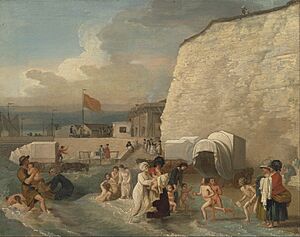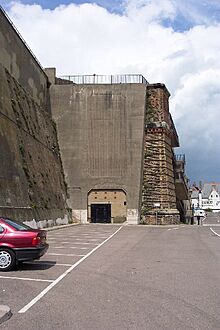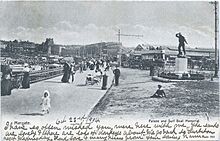History of Ramsgate facts for kids
For Ramsgate as a whole, see the main article Ramsgate.
Ramsgate got its name a long time ago! The earliest mention was in 1275 as 'Ramisgate' or 'Remmesgate'. This came from an old Anglo-Saxon phrase, 'Hraefn's geat', which meant 'Raven's cliff gap'. Later, in 1357, it became known as 'Ramesgate'.
Contents
Ramsgate's Rise as a Holiday Spot (1760s-1830s)
Before King George III became king, Ramsgate was just a small part of a nearby town called St Lawrence. But doctors started saying that swimming in the sea was good for your health! So, by the 1750s, towns by the sea began trying to attract rich visitors.
The first time we know this happened in Ramsgate was in 1764. A man named James Hawkesley had two sheds where women could change clothes. They would then wait for a "bathing machine" – a small hut on wheels that would take them into the water. You could also buy newspapers and snacks, and hire boatmen to row gentlemen into deeper water.
This business grew a lot! By the early 1800s, there were more than 20 bathing machines on Ramsgate sands. New owners replaced the sheds with nicer "Bathing Rooms." They even built a small row of shops, a market, and a billiard room.
At the same time, Ramsgate started building a new harbour. After a big storm in 1748, people asked Parliament to build a safe place for ships near Ramsgate. Even though another town, Sandwich, didn't like the idea, the plan was approved. Work on the port began in 1760.
However, the harbour kept getting filled with mud. So, in 1774, a famous engineer named John Smeaton was asked for help. After some tries, Smeaton's new plans for a harbour with piers (long walkways into the sea) and sluices (gates to control water) were used. Most of the work was finished by 1790.
But then, the threat of invasion from France stopped more building. Ramsgate became very important during the Napoleonic Wars. The naval harbour and military bases on the cliffs changed the town. It went from a small holiday spot to a place with military and social importance.
Many important people visited Ramsgate. The Prince Regent (who later became King George IV) was entertained at Cliff House. The Duke of Clarence (who became King William IV) held a fancy ball in 1811. The Times newspaper said it was the most fashionable and elegant event ever seen in that part of the country!
From 1803 to 1807, Admiral Keith, who commanded the North Sea and Channel Fleets, had his headquarters in Ramsgate. Also, Jane Austen's brother, Francis, helped organize a group called "Sea Fencibles." These were like a naval militia that protected the South Coast of Britain from invasion.
Between 1804 and 1816, over 300 ships came to Ramsgate Harbour. They took more than 50,000 soldiers, horses, and supplies to Europe. The biggest movement of troops happened in 1809 for the Walcheren Expedition. Many sick and wounded soldiers were brought back to Ramsgate. Sadly, many died and were buried in St Laurence Churchyard.
As the Napoleonic Wars ended, troops continued to move through Ramsgate. One young boy remembered seeing soldiers marching six abreast (side-by-side) through the town. Another person, Kenneth Beacham Martin, recalled the Household Cavalry and Royal Dragoons leaving from West Cliff. They boarded 34 ships heading to Ostend in 1815 to join Wellington's army and fight at the Battle of Waterloo.
In 1821, George IV became King. To visit his other kingdom, Hanover, the Royal Squadron (a group of royal ships) left from Ramsgate. The new King was so pleased with how the town welcomed him. When he returned, he made Ramsgate a "Royal Harbour." This is a special title that is still unique in mainland Britain!
After the wars, Ramsgate's military importance decreased. The threat from France was gone, and Britain started focusing more on its colonies. The military buildings were sold, and a lot of new houses were built.
What really helped Ramsgate grow was the steamboat service from London to Margate, which started in 1816. Instead of a long, bumpy coach ride, wealthy visitors could now travel to Thanet in just four hours by comfortable steamboat. So, many important people chose to relax in Ramsgate for a month or two.
Before 1790, there were hardly any big houses on the cliffs. But by 1837, when Queen Victoria became queen, Ramsgate was full of elegant crescents (curved rows of houses), squares, and lawns. These houses had beautiful bow-fronted designs and delicate ironwork. Ramsgate now has more historic buildings from this time, per person, than the city of Bath!
The official holiday season in Ramsgate was from August to October. But some regular visitors, like the poet Samuel Taylor Coleridge, preferred to stay in late autumn. This was mainly to save money. A house on Nelson or Wellington crescent could cost £16 a month, which was five or six times more than a similar house in London! But by November, Coleridge could rent a room on the cliff for much less.
In its best days as a fashionable holiday spot, Ramsgate attracted both new and old money. Two of the richest men in the kingdom, Sir William Curtis and Moses Montefiore, had large homes on West Cliff and East Cliff. In the town, you might see the Prime Minister, Lord Liverpool, walking with his Foreign Secretary, George Canning. You could also enjoy a warm seawater bath with important people like the Marquess of Wellesley or the Duke of Clarence. Or you could just watch the "Heir Presumptive" (the person next in line to the throne) riding a donkey on the beach.
Princess Victoria first came to Ramsgate in 1823 when she was only four years old. She visited regularly throughout her childhood, staying at Albion House and Townley House. These holidays gave the young princess a break from her strict upbringing. Even as Queen, Victoria loved the town and had good memories of the seaside. She was sometimes allowed to play on the sands with her dog or briefly mix with other children.
But, strangely, Victoria's time as queen marked the end of Ramsgate's status as a very stylish holiday resort. As medicine improved, people stopped believing that seawater had special health benefits. Also, with the growth of railways, many other places became easy to reach from London. Rich people started new trends, like country weekends or days at the races. Royalty now preferred the French Riviera to the North Sea coast.
Rents fell, and Ramsgate slowly declined during Victoria's reign. The town's economy shifted to fishing and more common tourism. Even Ramsgate's harbour became less important when Dover built its Western Docks in 1848. So, the last sight when leaving Britain was no longer the White Cliffs of Ramsgate, but the White Cliffs of Dover.
Today, much of Ramsgate's historic buildings and heritage from that time can still be seen. This helps create a good tourist trade with various walks and trails. You can wander from Wellington Crescent on the East Cliff to the Royal Crescent on the West Cliff. You can follow blue plaques (signs on buildings) to learn about the military and social history of the period. Down on the quay, there are many popular cafés and restaurants. You can also see the whole view of the Royal Harbour from the large sun-deck on top of the beautifully restored Royal Pavilion. This is the largest Wetherspoons (a type of pub) in the country, where locals and visitors enjoy the sun and fresh sea air.
Electric Trams in Ramsgate (1901-1937)
Around the year 1900, the Isle of Thanet got about 11 miles (18 km) of track for electric trams. The Electric Tramways & Lighting Co. Ltd started its service with electric trams on April 4, 1901. These trams connected the towns of Ramsgate, Margate, and Broadstairs.
On August 3, 1905, a very wet summer day, Tram Car No. 41 had an accident. As it was going down the steep Madeira Walk hill into Ramsgate harbour, it went out of control. It jumped off the tracks and crashed through the railings, falling over a 30-foot (9 m) cliff edge! Luckily, only a few passengers were on board, and they were not hurt. However, the driver, who was new, did get some injuries.
The Electric Tramways & Lighting Co. Ltd continued to operate without any more big accidents. Their services were replaced by buses from the East Kent Road Car Co on March 27, 1937.
This tramway was one of the few in Britain that ran between towns. It was owned by a private company and went through open countryside between the three towns. Much of the route was on its own special path, which only became public roads after the tramway closed.
The line started in Westbrook, west of Margate. A small tram-shed (where trams were kept) was there until recently. The tram tracks were supposed to be saved in the new housing development built there. The route went along Canterbury Road and the sea-front. Then it split into two. Towards Broadstairs, it went up Paradise Street. From Broadstairs, it came down Fort Hill and along King Street.
Other parts of the route included Fort Crescent, Athelstan Road, Northdown Road, and then a private track to Lower Northdown Road. This part is now a public footpath. It continued eastwards to the Wheatsheaf, then cut across the country to Northdown Hill. This is now a rough track. Past the main tram-shed, which is still there and used as factory units, it went into Westover Road. Then Church Street (over the railway) to St Peters, Albion Road to crossroads, left under the railway bridge by Broadstairs station, along Broadstairs High Street to Queens Road, Oscott Road, and the seafront. Then along a private path to Ramsgate, which is now Dumpton Park Drive. Finally, it went along Bellevue Road, Plains of Waterloo, Nelson Crescent, down Madeira Walk to Ramsgate Harbour. It then went up Royal Parade, Paragon, St Augustines Road, all the way along Grange Road, right at Park Road, to the old South Eastern Railway station. This was the end of the line.
There was also a short-cut between Ramsgate and St Peters called the Top Road. It ran from the crossroads by Broadstairs station, south along Osborne Road, Gladstone Road, across Ramsgate Road, and on a private path (now Salisbury Avenue) to the main line. This route was not used very much, and no one is sure why it was built.
The company wanted to extend the line to Birchington. However, landowners in Westgate, who owned housing estates, stopped them. They wanted to keep certain people away. Perhaps because of this, Westgate was not allowed to become its own urban district before World War I because it lacked "civic character." It later became part of Margate. A line to Pegwell village was also suggested.
The trams were double-decker, but the upper deck never had a roof, even in winter. This was because the track was narrow, and there were many sharp turns. Twelve people could fit into the lower deck, which had two wooden benches facing each other. But in bad weather, the top deck was very unpleasant. The tram service could not compete with buses all year round, even though people remembered the trams fondly on hot summer days.
Ramsgate's Railways
Between 1863 and 1926, Ramsgate Harbour had its own railway station. From 1936 to 1965, the harbour was connected to the railway at Dumpton Park by an underground railway system called the Tunnel Railway.
Ramsgate During Wartime
Because Ramsgate is so close to mainland Europe, it was a very important place for troops to leave from during the Napoleonic Wars. It was also crucial for the 1940 Dunkirk evacuation. During World War II, 4,200 ships left Ramsgate Harbour to rescue soldiers from the beaches of Dunkirk.
On May 24, 1990, the 50th anniversary of the Dunkirk evacuation was remembered. About 80 of the original 'little ships' gathered at Dover and Ramsgate to repeat the historic crossing. Only six of these ships had any problems, but others in the group helped them.
One of these 'little ships' was the first Motor lifeboat stationed at Ramsgate, named the 'Prudential'. It arrived in 1926. During World War II, the Ramsgate lifeboat and its crew were called out 60 times. They saved 170 lives, in addition to the men brought back from Dunkirk.
One of the Dunkirk 'little ships' that is still in Ramsgate and open to the public is the Motor Yacht Sundowner. It was built in 1912 and was once owned by C.H. Lightoller, the second officer of the Titanic. He survived the Titanic sinking and later insisted on personally steering the Sundowner during the Dunkirk evacuation. He managed to bring home 127 members of the British Expeditionary Force in just one trip!
After these events, 42,783 soldiers were transported from Ramsgate railway station. They were carried by 82 special Southern Rail trains. Ramsgate was the second busiest station during the evacuation, after Dover, which moved over 180,000 men with 327 trains.
Shortly before World War II began, the local council decided to make the existing tunnels under the town bigger. They would be used as a public air-raid shelter. After the war started, the government finally gave permission to spend the money. The shelters were built and used a lot during air raids. You can find more details on the Subterranea Britannica website.
Airfields Near Ramsgate
In 1915-1916, early aircraft started using the open farmlands at Manston for emergency landings. This location near the Kent coast was better than other airfields. By 1917, the Royal Flying Corps was well established there and helped defend England. The airfield played an important role in World War II and is now known as Kent International Airport.
A town airport was opened on July 1, 1935. It operated until Second World War broke out in 1939. After a short time as a smaller base for RAF Manston, it closed in 1940. The airport reopened in 1952 and operated until it closed for good in 1968.
Vincent van Gogh's Time in Ramsgate
The famous artist Vincent van Gogh lived in Ramsgate for a year starting in April 1876. He was 23 years old. He stayed at 11 Spencer Square and worked as a teacher at a local school in Royal Road. In one of his letters to his brother Theo, he described his surroundings: "There’s a harbour full of all kinds of ships, closed in by stone jetties running into the sea on which one can walk. And further out one sees the sea in its natural state, and that’s beautiful." Many artists have been inspired by the light in Thanet, including J. M. W. Turner, who lived in nearby Margate.
See also
- Historic buildings in Ramsgate
- List of people from Ramsgate





